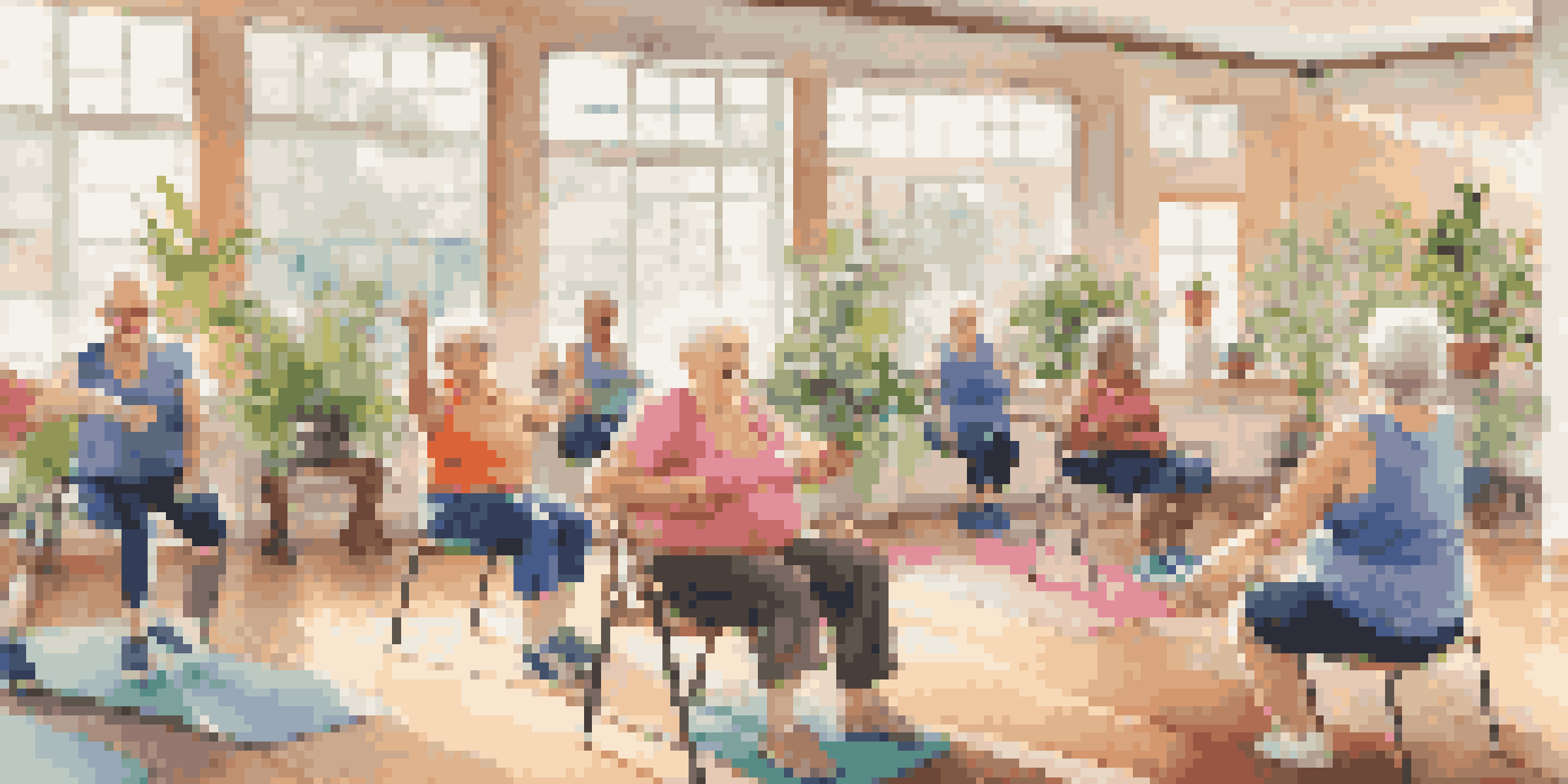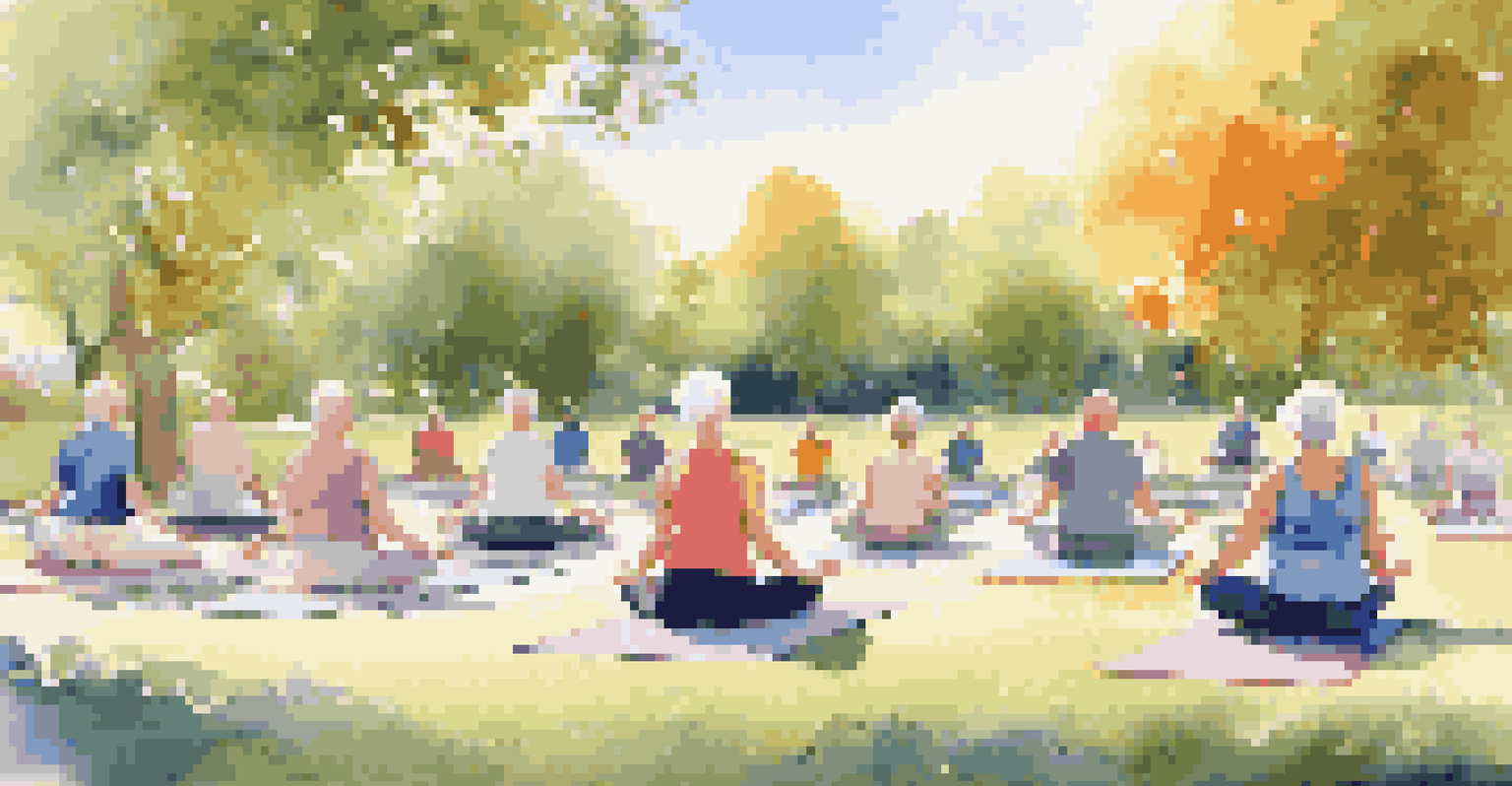Designing Fitness Programs for Seniors with Cognitive Impairments

Understanding Cognitive Impairments in Seniors
Cognitive impairments in seniors can range from mild forgetfulness to severe conditions like dementia. These changes can affect their ability to understand instructions and follow through with physical activities. It’s crucial to recognize how these impairments impact daily life, including fitness routines. By identifying specific cognitive challenges, we can tailor programs to better suit their needs and abilities.
Physical fitness is not only one of the most important keys to a healthy body, it is the basis of dynamic and creative intellectual activity.
For instance, a senior with short-term memory issues may struggle to remember exercise sequences. This highlights the importance of using clear, simple instructions and repetitive actions to reinforce learning. Engaging family members or caregivers can also provide valuable support, creating a familiar environment that encourages participation. Ultimately, understanding these cognitive nuances allows us to create more effective and enjoyable fitness experiences.
Additionally, we should consider the emotional aspects of cognitive impairments. Seniors may feel frustrated or anxious about their limitations, making it essential to foster a positive and encouraging atmosphere. This emotional support can significantly enhance their motivation and willingness to engage in fitness activities. By addressing both cognitive and emotional needs, we can create a holistic approach to fitness programming.
Setting Realistic Goals for Fitness Programs
When designing fitness programs for seniors with cognitive impairments, realistic goal-setting is key. These goals should be achievable and relatable, focusing on gradual progress rather than immediate results. For example, instead of aiming to complete a 30-minute workout, a more achievable goal might be to increase mobility through five minutes of light stretching. This approach not only boosts confidence but also encourages seniors to stay engaged.

It's important to involve seniors in the goal-setting process as much as possible. This involvement helps them feel a sense of ownership over their fitness journey, which can enhance motivation. Celebrating small successes along the way reinforces positive behavior and encourages continued participation. Remember, progress is a journey, and every step counts!
Understand Cognitive Challenges
Recognizing cognitive impairments in seniors allows for tailored fitness programs that cater to their specific needs and abilities.
Furthermore, adaptability is crucial in this process. As seniors progress or face new challenges, their goals should evolve accordingly. Regular check-ins can help assess their comfort levels and capabilities, ensuring that the program remains relevant and beneficial. This dynamic approach to goal-setting fosters a sense of accomplishment and keeps seniors excited about their fitness journey.
Incorporating Safe and Engaging Activities
Safety is a top priority when designing fitness programs for seniors, especially those with cognitive impairments. Activities should be low-impact and tailored to individual abilities to minimize the risk of injury. For instance, chair exercises can be a great option, providing support while still promoting movement. By selecting safe activities, we create an environment where seniors feel secure and confident to participate.
To keep the body in good health is a duty... otherwise we shall not be able to keep our mind strong and clear.
In addition to safety, engagement is vital to keep seniors interested in their fitness routines. Activities should be varied and enjoyable, incorporating elements of fun to maintain motivation. Group settings can enhance social interaction, making exercise feel less like a chore and more like a social event. Consider activities like dance classes or gentle yoga, which not only promote fitness but also encourage camaraderie.
Moreover, using familiar music or themes during workouts can evoke positive memories, further enhancing engagement. This connection to the past can make the experience more meaningful and enjoyable for seniors. By combining safety with engaging activities, we can create a fitness program that seniors look forward to, ultimately fostering a healthier lifestyle.
Focusing on Social Interaction and Community
Social interaction is a powerful motivator, especially for seniors. Incorporating community aspects into fitness programs can significantly enhance participation and enjoyment. Group classes or buddy systems encourage seniors to connect with others, reducing feelings of isolation that often accompany cognitive impairments. A friendly environment can make a world of difference in their motivation to engage in fitness activities.
Encouraging friendships among participants can lead to a more supportive atmosphere where seniors feel comfortable sharing their experiences and challenges. This camaraderie not only boosts morale but also creates accountability, as they cheer each other on. For instance, organizing team challenges or social events can strengthen these bonds, making fitness a shared journey rather than a solitary task.
Set Achievable Fitness Goals
Establishing realistic and relatable goals enhances seniors' motivation and engagement in their fitness journey.
Additionally, involving families in the program can further enrich the experience. Family members can participate in exercises, attend classes, or help with encouragement at home. This support system reinforces the importance of fitness and offers seniors a sense of belonging. By prioritizing social interaction, we create a holistic approach to fitness that nurtures both physical and emotional well-being.
Utilizing Technology in Fitness Programs
In today's digital age, technology can play a vital role in enhancing fitness programs for seniors with cognitive impairments. Simple devices like pedometers or fitness trackers can motivate seniors to stay active by setting daily step goals. These tools not only promote physical activity but also provide a sense of accomplishment as they track their progress. Integrating technology can make fitness more interactive and enjoyable.
Moreover, online classes or virtual fitness resources can be beneficial, especially for those who may have mobility issues or prefer exercising at home. These platforms often offer a variety of workout options tailored to different abilities, allowing seniors to choose what resonates with them. Encouraging familiarity with technology can also stimulate cognitive function, providing an additional layer of benefit.
However, it’s essential to ensure that technology is user-friendly and accessible for seniors. Providing clear instructions and assistance can help alleviate any intimidation they may feel. By embracing technology, we can create a more engaging and versatile fitness program that meets the diverse needs of seniors with cognitive impairments.
Evaluating and Adapting Fitness Programs
Regular evaluation of fitness programs is crucial to ensure they remain effective and relevant for seniors with cognitive impairments. Gathering feedback from participants can provide valuable insights into what works well and what may need adjustments. This collaborative approach helps in fine-tuning the program, making it more aligned with the needs and preferences of seniors. After all, their input can inform future activities and goals.
Additionally, monitoring physical and cognitive progress can help identify areas of improvement. This assessment can include tracking mobility, strength, and overall engagement in the program. By recognizing trends, we can adapt the fitness routine to better suit individual capabilities. For instance, if a participant shows improvement in balance, we may introduce new challenges to keep them motivated.
Encourage Social Interaction
Incorporating community elements into fitness programs fosters social connections, significantly boosting participation and enjoyment.
It's also important to remain flexible and open to change. As cognitive impairments can fluctuate, being responsive to these changes can enhance the overall experience. Regular check-ins and adjustments ensure that seniors continue to benefit from the program while feeling supported throughout their fitness journey.
The Importance of Encouragement and Support
Encouragement and support are essential elements in the success of fitness programs for seniors with cognitive impairments. Positive reinforcement can significantly boost their confidence and willingness to participate. Simple phrases like 'You did great today!' or 'I’m proud of your progress!' can go a long way in fostering a supportive environment. This kind of encouragement can help seniors feel valued and motivated to continue their fitness journey.
Creating a supportive community among participants is also vital. When seniors see others facing similar challenges, it can alleviate feelings of isolation and anxiety. Group activities can help build relationships, and the shared experience of overcoming obstacles together fosters a sense of belonging. This emotional support can be a powerful motivator for seniors to stay engaged and committed.

Lastly, training staff and caregivers to provide consistent encouragement can enhance the overall effectiveness of the program. They can be instrumental in creating a positive atmosphere that empowers seniors. By focusing on encouragement and support, we can cultivate an environment where seniors feel inspired to embrace fitness, regardless of their cognitive challenges.